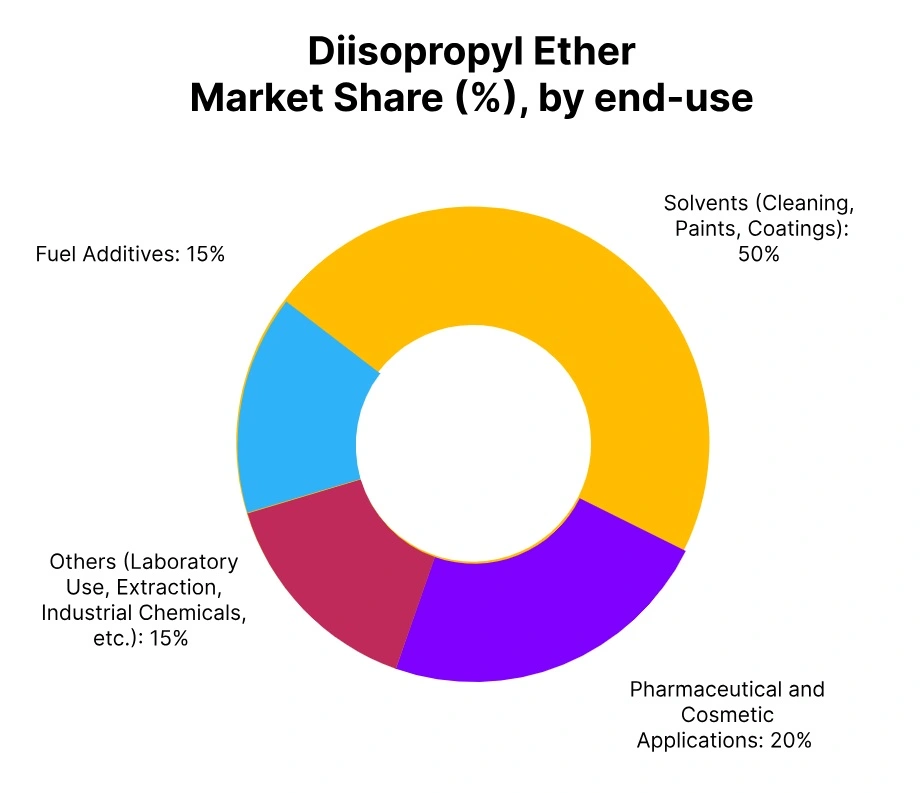Price-Watch’s most active coverage of Diisopropyl Ether price assessment:
- IG (99% min) FOB Shanghai, China
- IG (99% min) FOB Hamburg, Germany
- IG (99% min) CIF Mersin (Germany), Turkey
- IG (99% min) FD Antwerp, Belgium
- IG (99% min) CIF Jeddah (China), Saudi Arabia
- IG (99% min) CIF Busan (China), South Korea
- IG (99% min) CIF JNPT (China), India
Diisopropyl Ether (DIPE) Price Trend Q3 2025
During the third quarter of 2025, moderate price increases characterized the Diisopropyl ether (DIPE) market globally, buoyed by consistent demand from chemical and solvent sectors. Moderate to moderate price increases have been realized in several regions, including stability for the product in both China and Germany and Belgium in the liquified gas market, thus prices overall increased.
Overall price increases in several regions confirmed stable industrial demand, even as a worldwide economic slowdown developed. Demand for Diisopropyl Ether (DIPE) had continued upward in September 2025, with consumption remaining steady across key industries. Incremental price overall increases across several regions indicated relatively balanced demand and supply with no significant production or distribution disruptions.
Belgium
Diisopropyl Ether (DIPE) domestically traded prices FD Antwerp, Belgium, Grade- Industrial Grade (99% min).
Diisopropyl Ether (DIPE) prices in Belgium increased by 3.0%, reaching 1717 USD/MT in Q3 2025. The price rise has been driven by relatively stable demand within the European Union, particularly from the solvent and chemical sectors. Belgium’s role as a trading hub for Diisopropyl Ether (DIPE) contributed to stable price movements.
In September 2025, the Diisopropyl Ether (DIPE) price trend in Belgium continued to reflect the broader European market conditions, with prices maintaining an upward trajectory. The price increase in Belgium has been a direct result of steady demand in key downstream industries across the region. Diisopropyl Ether (DIPE) price trend in Belgium remained high, reflecting consistent demand in the market.
Germany
Diisopropyl Ether (DIPE) Export prices FOB Hamburg, Germany, Grade- Industrial Grade (99% min).
In Q3 2025, the Diisopropyl Ether (DIPE) price trend in Germany rose 2.8% to 1650-1700 range USD/MT. The increase has been propelled by constant demand from the European chemical and pharmaceutical industries. The price rise has also been supported by advantageous market conditions for Exports to neighboring regions.
In September 2025, Diisopropyl Ether (DIPE) prices in Germany continued to trend upward aligned with global prices, which remained steady despite the slow global economy. Overall Diisopropyl Ether (DIPE) price trend in Germany exhibited strength, continuing to trend upward in contrast to other lower European industrial activity. The price increase suggests that sufficient demand remained in Europe.
Turkey
Diisopropyl Ether (DIPE) Import prices CIF Mersin, Turkey; Grade- Industrial Grade (99% min).
Diisopropyl ether prices in Turkey increased by 2.5%, reaching 1739 USD/MT in Q3 2025. The price rise was driven by stable demand in the Turkish chemical and pharmaceutical industries, which helped support the higher Import prices. Turkey’s reliance on Imports from Germany meant that local price movements were influenced by European market conditions.
In September 2025, the diisopropyl ether prices in Turkey followed the upward trajectory seen in other regions, with prices reflecting stronger market conditions. Diisopropyl Ether (DIPE) price trend in Turkey continued to increase, in line with global price trends.
Saudi Arabia
Diisopropyl Ether (DIPE) Import prices CIF Jeddah, Saudi Arabia, Grade- Industrial Grade (99% min).
In the third quarter, Diisopropyl Ether (DIPE) price trend in Saudi Arabia remained firm, reflecting continued demand from key industrial sectors. Diisopropyl ether prices in Saudi Arabia rose by 3.4%, reaching 1735 USD/MT in Q3 2025. The price increase has been driven by higher demand from the chemical industry, particularly in the production of solvents and other specialized chemicals.
Saudi Arabia’s Import dependency on China for DIPE Imports also influenced the price movement. In September 2025, the Diisopropyl Ether (DIPE) prices in Saudi Arabia continued to reflect the global market rise, as prices in the region stayed elevated.
China
Diisopropyl Ether (DIPE) Export prices FOB Shanghai, China, Grade- Industrial Grade (99% min).
The Diisopropyl Ether (DIPE) price trend in China rose 3.0%, reaching USD 1626/MT in Q3 2025. The increase in price has primarily been a function of steady demand from the chemical and solvent sectors, and increased exports. The demand for diisopropyl ether has been high enough to stabilize production while the increased global demand provided a supportive price environment.
In September 2025, diisopropyl ether prices remained on the higher-end within the Chinese market during Q3. The Diisopropyl Ether (DIPE) price trend in China followed suit of the increase in global prices led by continued demand in multiple uses.
South Korea
Diisopropyl Ether (DIPE) Import prices CIF Busan, South Korea, Grade- Industrial Grade (99% min).
In Q3 2025, the prices of diisopropyl ether in South Korea experienced a 3.0% increase to reach 1655 USD/MT. The price increase has occurred due to strengthened demand from the solvent sector and other industrial chemical applications, where production remained stable amid a tumultuous global economy. Since South Korea sources DIPE from China, the price increase only reflected global supply trends.
In September 2025, diisopropyl ether prices in South Korea continued to reflect positive price movements seen globally. The South Korean price trend of diisopropyl ether has increased consistently, continuing the steady upward trend based on the global market demand seen within other countries regional and global market.
India
Diisopropyl Ether (DIPE) Import prices CIF Nhava Sheva, India, Grade- Industrial Grade (99% min).
According to Price-Watch, the Diisopropyl Ether (DIPE) price trend in India remained firm and elevated. Diisopropyl ether prices in India increased by 6.4% in Q3 2025. The significant rise in prices has been attributed to strong demand from the chemical, pharmaceutical, and solvent sectors.
The increase has also been driven by higher Import costs from China, reflecting global market pressures. In September 2025, the Diisopropyl Ether (DIPE) prices in India showed continued upward movement, with prices reflecting stronger demand and Import dependency on China.






